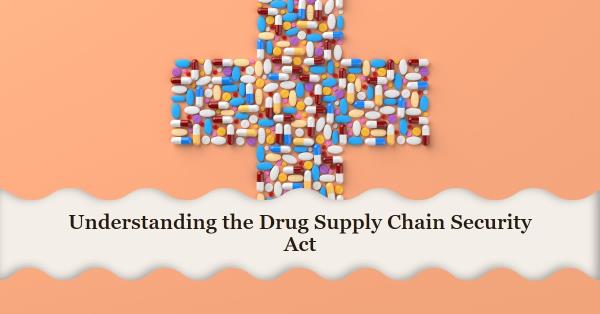The Drug Supply Chain Security Act (DSCSA) was passed in 2013 to ensure that drugs are safe and secure as they move through the supply chain. The DSCSA requires all participants in the drug supply chain, including manufacturers, distributors, repackagers, and dispensers, to establish an electronic system for tracking and tracing prescription drugs.
This system is designed to improve safety by allowing regulators and manufacturers to quickly identify and respond to any problems that arise. Understanding the DSCSA can be challenging due to its complexity and numerous requirements. However, it is critical for everyone involved in the drug supply chain to have a clear understanding of the law in order to comply with its regulations and ensure patient safety.
In this article, we will provide an overview of the DSCSA and explain its key provisions. We will also discuss how the law has been implemented so far and what changes are expected in the future. Whether you are a manufacturer, distributor, repackager, or dispenser of prescription drugs or simply interested in learning more about this important area of healthcare regulation, this article will provide valuable insights into one of the most significant pieces of legislation affecting our industry today.
Table of Contents
The Purpose And Scope Of The Dscsa
The Drug Supply Chain Security Act is a federal law that was enacted in 2013 to address the growing concern over counterfeit drugs and drug shortages in the United States.
The law aims to establish a system for tracking and tracing prescription drugs as they move through the supply chain from manufacturer to wholesaler to pharmacy. This system will help ensure that drugs are safe, effective, and available when needed.
The DSCSA applies to all prescription drugs sold in the United States, including both brand-name and generic products. It requires all parties involved in the drug supply chain to implement specific procedures for identifying and tracking each drug product.
These procedures include using unique product identifiers, maintaining electronic records of all transactions, and reporting any suspicious activity or incidents of counterfeit drugs to the appropriate authorities. By implementing these measures, the DSCSA seeks to improve patient safety by reducing the risk of contaminated or counterfeit drugs entering into the supply chain.
Requirements For Product Identification And Tracing
Let’s face it, the drug supply chain is complex and often leaves room for errors, which can have severe consequences. The Drug Supply Chain Security Act (DSCSA) aims to enhance the safety of patients by establishing standards for tracing drugs as they move through the supply chain. As part of this act, there are requirements for product identification and tracing that manufacturers, repackagers, wholesale distributors, and dispensers must follow.
Product identification is a critical aspect of the DSCSA because it enables stakeholders to track a drug’s movement from one point in the supply chain to another. Each package or container of a prescription drug must bear a unique product identifier that includes its National Drug Code (NDC), serial number, lot number, and expiration date. This requirement ensures that all parties involved in the supply chain can easily identify and trace products if needed.
Additionally, there are provisions in place to ensure accurate data exchange between trading partners, further promoting transparency and accountability within the drug supply chain.
Verification And Reporting Obligations
As part of the Drug Supply Chain Security Act (DSCSA), manufacturers, repackagers, wholesale distributors, and dispensers are required to verify and report certain information about prescription drugs. These obligations are critical for ensuring the safety and integrity of the drug supply chain.
Verification obligations require all parties in the supply chain to confirm that the product they receive is legitimate. This includes checking for any signs of tampering or damage to packaging, verifying the product identifier and expiration date, and confirming that the product was obtained from an authorized source.
Reporting obligations, on the other hand, require parties to share information about transactions and any suspect or illegitimate products discovered within the supply chain. By fulfilling these obligations, stakeholders can help prevent counterfeit or adulterated drugs from entering the market, ultimately protecting patients’ health.
Challenges And Opportunities For Industry Stakeholders
Industry stakeholders face both challenges and opportunities in implementing the Drug Supply Chain Security Act (DSCSA). The act requires a coordinated effort between manufacturers, distributors, dispensers, and other stakeholders to ensure the safety of drugs throughout the supply chain.
One challenge is the cost associated with implementing new technology and processes to comply with DSCSA regulations. This can be especially burdensome for smaller companies or those with limited resources.
However, there are also opportunities for industry stakeholders to improve their operations and enhance patient safety through compliance with DSCSA regulations. By increasing visibility into the supply chain and ensuring the authenticity of drugs, stakeholders can reduce the risk of counterfeit or contaminated products reaching patients.
Additionally, by streamlining processes and improving communication between supply chain partners, stakeholders can increase efficiency and reduce costs in the long run. Overall, while there may be initial challenges in implementing DSCSA regulations, industry stakeholders have a unique opportunity to improve their operations and protect patient safety through compliance.
Conclusion
In conclusion, understanding the Drug Supply Chain Security Act (DSCSA) is essential for all stakeholders in the pharmaceutical industry.
The DSCSA aims to safeguard the integrity of the supply chain by ensuring that drugs are safe and effective from manufacturer to patient. It outlines requirements for product identification and tracing, verification, and reporting obligations.
While the DSCSA presents challenges for industry stakeholders such as manufacturers, distributors, and dispensers, it also provides opportunities to improve efficiency and transparency in the supply chain.
By complying with these regulations, companies can build trust with consumers and increase patient safety. As a result, it is crucial for all stakeholders to educate themselves on the DSCSA’s requirements and stay up-to-date with any changes or updates.

